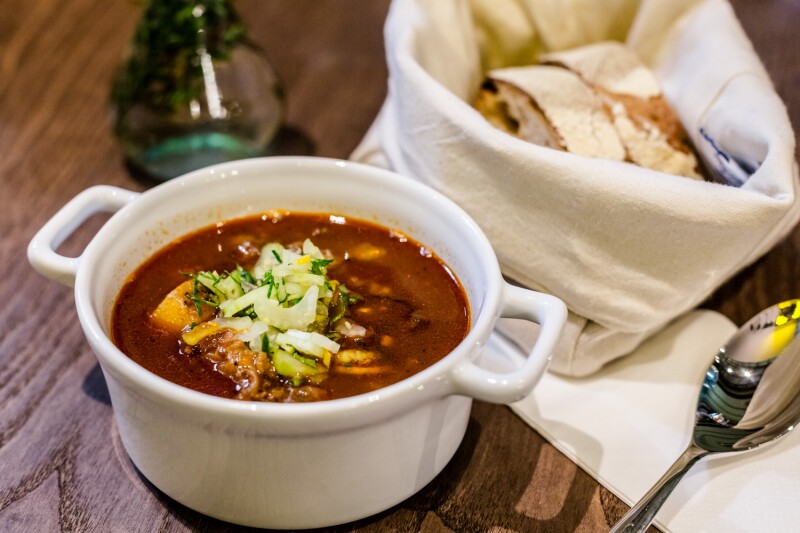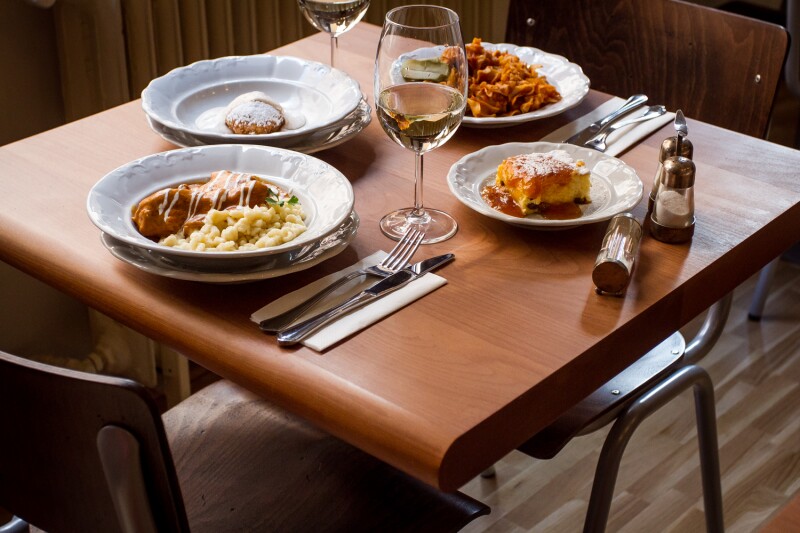At the crossroads of Central Europe, with the Danube River directly connecting it to much of the continent, Hungary has felt the influence of many different cultures. Hungarian cuisine, in particular, has picked up ideas from Turkish food (thanks to the 150-year Ottoman occupation), as well as from the other nations of the Austro-Hungarian Empire and traditional Jewish cuisine.
Even Hungary’s signature spice, paprika, comes from somewhere else. Pepper plants arrived in Europe in the 16th century, brought back from the Americas by sailors. Paprika only became widely used in Hungary in the mid-18th century.
The classic national cuisine that resulted from all these outside influences may be undergoing yet another major change in Budapest: Old recipes are being reconsidered and embellished by creative chefs who have turned the city into a global food destination.
We’ve compiled a list of essential Hungarian dishes to try during your visit to Budapest, as well as the restaurants where you should seek them out. (Be sure to try Hungary’s fine wines, too.)
Lecsó (Hungarian ratatouille)
When tomatoes and sweet peppers are at peak ripeness, Hungarians buy them in quantity to make lecsó, a vegetable side dish of tomatoes and sweet yellow peppers, cooked down with a bit of smoked lard or oil and, of course, some paprika. Every family has its own preferred ratio of peppers to tomatoes (it’s mostly peppers), and the concoction is often canned to last through the year.
Lecsó can be eaten on its own with a dollop of sour cream and a sprinkle of hot paprika. Or it can be a component of other dishes, such as túrós csusza (pasta with cottage cheese), served on top of eggs or a slice of bread, or on a plate next to meat roasts or sausage. Like so many Hungarian recipes, lecsó can be made at home or ordered at fancy Budapest restaurants. It’s versatile enough to pair well with very different wines: a dry stony furmint from Tokaj or with a more fruity kékfránkos from Eger.
In season, lecsó is served everywhere. The menu at Michelin-starred Borkonyha Winekitchen changes often, but if you’re lucky you’ll find it accompanying steak and sausage. Café Kör, a traditional bistro near the Basilica, offers lecsó as a side dish.

So, you think you know goulash?
Photo by Hartyanyi Norbert; courtesy of Stand25 Bisztró
Gulyás (goulash)
Gulyás, or goulash, is the Hungarian dish most people think they know. But in Hungary a true gulyás is not a stew. Rather, it’s a hearty soup made with lots of paprika and onions, beef (sometimes mutton), potatoes, and csipetke (pinched pasta). “Outside Hungary, almost all the dishes seasoned with paprika are labeled goulash,” writes Károly Gundel, a famous Hungarian chef, in his 1937 classic Hungarian Cookery Book. While gulyás is a dish linked to the national identity, cooks can make minor variations and still call it by its name, as they do at home and on menus from simple lunch canteens to Michelin-starred restaurants.
The word gulyás means “cowboy”—the dish originated with ninth-century cowherders who carried sun-dried meat and, “whenever they wanted food, they took out a piece of the dried meat, added some water and reheated it,” writes George Lang in his 1971 book The Cuisine of Hungary. It remains a simple everyday meal, usually eaten with thick slices of white bread, and is often prepared over an open fire in a bogrács (cauldron). Pair it with a light Hungarian red wine, such as a kadarka or kékfrankos.
Stand25 Bisztró, a simple bistro located in the Hold Street Market, often serves gulyás. So does its more upscale sister restaurant, Stand Étterem. You can always count on finding a nice gulyás at Náncsi Néni in the Buda hills.
Charcuterie
You can’t walk far in Budapest without coming upon a butcher shop packed with charcuterie, or prepared meats. The standard selection includes strings of orange paprika-spiked sausages, bacon in various cuts and styles, salamis, cold cuts, smoked pork hocks, head cheese, and tubs of cracklings. Even with the butchers’ extensive displays of smoked duck and goose breasts and other meaty treats, the preferred local meat is pork. “Perhaps the extraordinary quality of pork in Hungary contributed to the popularity of dishes made with pork, or perhaps it was the other way around,” writes George Lang in The Cuisine of Hungary. “The fact is that what beef is to Argentina and veal to Italy, pork is to Hungary.”
Dive into the local enthusiasm for meat by shopping the butcher stalls at one of the city’s market halls—the Great Market Hall, Hunyadi Square Market, Hold Street Market, or Fény Street Market are all great options for items to enjoy on a riverside bench or on a picnic in City Park. Or head to Bock Bisztró and order its mixed platter, a feast of Hungarian meat and cheese.

With a stock enriched by bone marrow, this soup is a carnivore’s delight.
Photo by Juhasz Norbert; courtesy of Pozonyi Vendeglo
Húsleves (“meat soup”) and csontvelő (bone marrow)
Soup is an integral part of a Hungarian meal. Húsleves, one of the beloved standards, is a rich consommé made by slowly simmering beef and marrow bones. A variety of different accompaniments can then be added to the stock, like root vegetables, thin egg noodles, matzo balls, or liver or semolina dumplings.
But the soup is usually a starter to the meal, especially when served at home. After the soup course comes tender boiled beef, served with mustard and horseradish, which is then followed by the climax of the meal: thick beef shank bones, with rich bone marrow the consistency of a buttery crème brûlée. Spread the marrow on toast and sprinkle with salt and paprika.
Húsleves is also found on the menus of almost every Hungarian restaurant. But to experience the almost primal pleasure of eating the marrow straight from the bone, you’ll have to look a bit harder. Bone marrow is served as an appetizer at Pozsonyi Kisvendéglő. The classic Kéhli Vendéglő in the Óbuda neighborhood offers bone marrow with toast and garlic as an appetizer or the soup with the bone marrow can be ordered as an entrée.
Sólet (cholent)
The influence of Jewish cuisine is so strong and long-standing that often locals don’t know that cholent, matzo balls, and goose soup weren’t originally Hungarian dishes. Sólet (cholent), a bean stew, is traditionally started on Friday afternoon by Jewish cooks then left to bake in a low-temperature oven overnight for the Sabbath meal. The Hungarian variation adds paprika, onions, boiled eggs, and a meat (such as goose, duck, smoked brisket, or sometimes even the very not-kosher pork).
At Rosenstein, Budapest’s most popular Jewish restaurant, a sophisticated sólet served on Fridays merits a pilgrimage. The beans are slowly cooked with stuffed goose neck, a creamy roasted egg, and smoked brisket. Kádár Étkezde, a no-frills lunchroom in the old Jewish quarter, makes it on Saturdays (be prepared for a line out of the door). You can get sólet (with your choice of topping) every day at Fülemüle, a Jewish restaurant in the Palace District.

Variations on a theme of pörkölt are the norm.
Photo by Laszlo Balkanyi; courtesy of ttó Gulyás
Pörkölt and paprikás (stews)
Pörkölt and paprikás are simply names used for plain stews that provide a starting place for culinary variations. “These names were not adopted from popular usage but were rather the result of a gentleman’s agreement among restaurateurs to give uniform names to the different ways of preparation,” wrote chef Károly Gundel.
Pörkölt is a slow-cooked paprika-spiced stew that can be made from any kind of meat (or even gizzards, fish, or mushrooms). The meat is simmered for hours in nothing but a little water, paprika, and lots of minced onions. At the table, it’s usually accompanied by a starch: boiled potatoes, galuska (flour dumplings), or fresh bread.
Paprikás is also made by slowly braising meat in smoked bacon fat with onions, tomato, and paprika; at the end, sour cream is stirred in. The resulting stew is often served with túrós csusza (noodles made with cheese) or galuska. Paprikás csirke (chicken paprikás) is the best-known version, but the dish can be made with veal, lamb, or fish.
Gettó Gulyás, a restaurant in the seventh district not far from the Great Synagogue, is devoted entirely to Hungarian stew. It calls itself a pörköltöző (which roughly translates to “a place to get pörkölt”) and offers more than a dozen variations on the theme.
Mangalica
Mangalica, a heritage breed of pigs, had nearly disappeared by 1989 when communism ended in Hungary. The hogs, which prefer foraging, were poorly suited to the era’s industrial pig farms. But since the early 1990s, as many food and drink traditions that were interrupted or forgotten during communism have been revived, Mangalicas have also regained their popularity.
The breed has a thick curly coat that makes them look a bit like a pig crossed with a sheep. They are prized for the velvety and abundant fat that marbles their flesh, making the meat perfect in sausage, cured charcuterie, and salami: You’ll never think of pork the same way after tasting this intensely flavorful meat. Mangalica sausage and hams are sold at the Great Market Hall. Textura often offers a Managlica dish—for example, a heritage pork loin with polenta and eggplant.
Dobos torta
The Dobos torta, an iconic layer cake, was invented in Budapest by chef and culinary entrepreneur József Dobos and debuted at the 1885 National General Exhibition in Budapest, a fair attended by Queen Victoria and Emperor Franz Joseph. Dobos torta’s six thin, buttery sponge cake layers alternate with five layers of chocolate buttercream, and ground hazelnuts dust its sides. The cake’s unique top shell of hardened caramel was a practical invention for Dobos and his bakery business. The hard caramel top kept the cake fresh longer without refrigeration, and this improved shelf-life allowed him to ship the tortas all over Europe. His custom-designed wooden boxes also helped keep the cakes cool and perfectly intact during their journey. József Dobos’s shop is long gone, but many of Budapest’s fine patisseries make (and ship) their own Dobos torta, including Centrál Café, Auguszt Cukrászda, and Daubner Cukrászda.
If you want to get a big mouthful of Budapest’s food heritage, sign up for the Authentic Flavors of Jewish Budapest, a full-day food tour led by a local Jewish scholar and arranged by AFAR’s travel partner, Context.
>>Next: The Perfect 3-Day Travel Itinerary to Hollókő, Hungary











